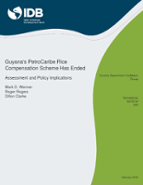Guyana's PetroCaribe Rice Compensation Scheme Has Ended: Assessment and Policy Implications
Date
Feb 2016
The government of Guyana signed a rice compensation agreement with Venezuela in 2009 wherein Guyanese rice exports were accepted in partial payment for imports of Venezuelan oil. The agreement ended in November 2015 and was not renewed for 2016. The scheme had provided stimulus to the Guyanese rice sector, resulting in higher levels of investments in improved inputs and machinery, an expansion in area cultivated, higher levels of outputs, higher levels of exports, and increased employment. The main incentive was the payment of a market premium, averaging 20 percent greater than world price. Despite improvements in yields, the average cost of production for a metric ton of Guyanese rice has remained uncompetitive compared with other leading exporters of rice (US, India, Pakistan, Thailand, Vietnam), limiting export market diversification opportunities. Because the scheme ended, Guyana must now place all of its exportable surplus in alternative markets. Without dramatic reductions in the cost of production, Guyana's response strategy will be limited to searching for premium bilateral deals and improving value-added processing activities. At present, Cambodia and Myanmar are displacing Guyana's rice exports to the European Union market, and Vietnam has entered into a supply agreement with Haiti, one of Guyana's Caribbean Community markets. This paper assesses the implications of Guyana's vulnerability in this scenario and offers recommendations to assuage the risks of a sharp price reduction.




